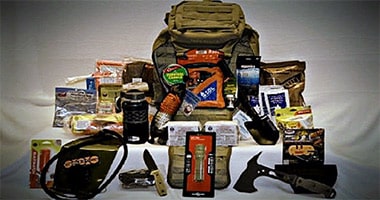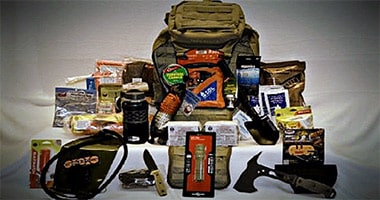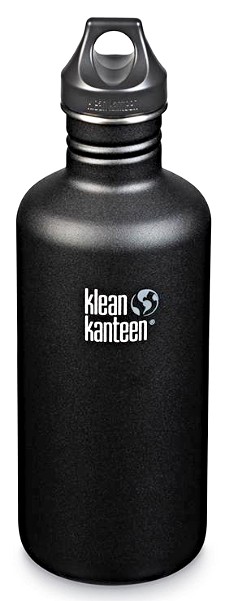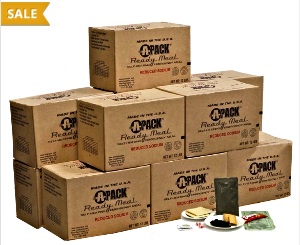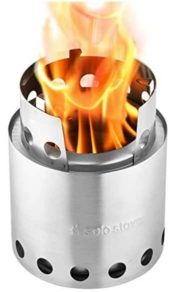Skilled Survival’s Ultimate 104-Item Bug Out Bag List
A free bug out bag checklist that tells you what to add to your pack and why.
Because you have to justify everything you add to your bag.
Every ounce matters.
Decisions must be made because you cannot take everything.
This checklist helps to make those hard decisions, so you end up with the perfect bug out bag for you.
A go bag you can be proud of.
Before we jump in, make sure to bookmark this page right now so you can come back to this free bug out bag list to build out your bag over time.
Go ahead, before you forget.
UPDATE: I recently published a new video going over my own bug-out bag build. I highly recommend checking it out and then reading the rest of this article for more bug-out gear ideas – “Just In Case” Jack
↓My EXACT Bug Out Bag Build ↓
A Quality Bug Out Bag
Before you begin filling your bag with all your survival gear and supplies, you need a high-quality bag.
Starting your build with a crappy pack is a terrible idea, so make certain you get one with the following qualities:
- Made with thick, tough fabrics
- Includes a MOLLE system
- Has a chest strap or padded hip support straps
- Water-resistant or includes a shell
- High-quality zippers and clips
- Includes a lot of pockets and compartments
And if you’re not familiar with MOLLE, watch this short video:
↓ Everything You Need To Know About MOLLE ↓
1. Bug Out Bag
The EVATAC™ Combat Bag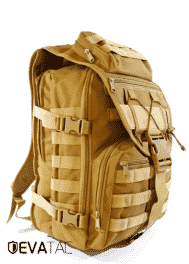
It’s the bag that I personally use, by the way.
It’s constructed of 600D Polyester, which makes it tough as nails.
The Combat Bag’s zipper and clips are heavy-duty and long-lasting.
The padded shoulder straps make carrying this very comfortable, and there is a chest strap that can sinch it down tight to keep it in place if/when you need to run.
There are a total of 10 compartments that can help keep you and your survival gear organized. By the way, these compartments are waterproofed to keep your gear dry.
There’s even a padded compartment that can fit a laptop or other sensitive gear.
The best news is that, at the time of writing, this bug out bag sells for a fraction of the price of similar bags.
Interested? Check out my detailed review of The Combat Bag by EVATAC:
↓ Bug Out Bag Review – The Combat Bag By EVATAC ↓
Once you’ve got your bug-out bag, it’s time to add some survival gear.
Please Note: This bug out bag list is intended to provide all the possible items you may want to add to your bag.
However, if you add everything suggested from this bug out bag checklist, it will get way too heavy.
You should pick and choose the gear and supplies that make the most sense to meet your needs.
Want a Downloadable and Printable Version Of This Bug Out Bag Checklist? Click Here To Get Your FREE Copy Of It.
Water And Hydration Tools
For SHTF, you will want at least three ways to your water sources. Drinking contaminated water can make you severely sick and can even kill you.
Why not just carry all the water you’ll need?
Not an option; water is extremely heavy, so you’ll have to find it along the way.
That’s why you’ll need key purification tools to filter and treat the water you find.
2. Stainless Steel Water Bottle
Your choice of water bottle matters.
It’s important to get a water bottle made out of stainless steel and not plastic.
You can’t boil water in a plastic bottle or an insulated one, and boiling is the simplest way to purify the water to ensure it’s safe to consume.
Double-wall (or even triple-walled) water bottles make it darn near impossible to boil water over a fire.
But you’ll want boiling water as a “backup” purification plan when bugging out.
Purifying your water from a lake or stream is way more important than keeping the water cool!
That means you ONLY want single-walled stainless steel for your bug out water bottle.
Fill your single-wall stainless steel bottle today with safe, clean water and stash it in your bug out bag.
That way, you can start your bug with a full bottle of clean water and then refill, boil/filter/purify as needed on your route.
3. Water Purification Tablets
An alternative method to purify water from rivers and streams when boiling is too time-consuming is to carry some water purification tablets.
These tablets treat water faster than boiling, allowing you to purify on the go and keep moving.
Plus, they are extremely lightweight, so you won’t pay much of a weight penalty.
4. Portable Water Filter
A good water filter will remove all the particulates from your water, such as dirt or soot, but a great one will also remove the most harmful bacteria as well.
So you should pack a small portable water filter to clean your water and purify it too.
Sawyer Mini Water Filter
I highly recommend you get a couple of Sawyer mini water filters.
Not only is it small to pack and lightweight, but it can also filter 100,000 gallons of water!
This little water filter is ideal for both travel and a worst-case get-home survival scenario.
What makes the Sawyer Mini so powerful is its inline design capabilities.
Use it like a straw or an inline filter to remove 99.999% of harmful bacteria.
Here’s my full video review of the incredible Sawyer Mini.
↓ Sawyer Mini Water Filter Review – Can This Filter 100,000 Gallons? ↓
5. Expedition Jerrycan Filtration System
This is not a small filter and won’t fit inside your bug out bag. However, with your MOLLE system, you can hang it on the outside of your bag.
The LifeSaver Expedition Jerrycan is ideal for a family bug out since the system can supply enough clean water for a family of 4 for nearly a year.
Clip it to the outside of your pack empty and use it once your family arrives at your final bug-out location.
Want a Downloadable and Printable Version Of This Bug Out Bag Checklist? Click Here To Get Your FREE Copy Of It.
Bug Out Food Supplies and Tools
You need to pack some calories.
A few essential foods to keep you healthy and maintain your stamina. Otherwise, you’re bug out bag will get too heavy.
So focus on light, easy-to-prepare foods.
But you should also try to take advantage of what the land can provide.
So make sure to pack a few survival tools to help hunt or gather additional food on your bug out route.
6. Calorie Dense Food Bars
Honestly, any calorie-dense energy bars will do the trick.
Just read the label and look for the ones that provide the most calories per bar.
These ER Emergency Food Ration Bars pack 2400 calories per bar, which is exactly what you need.
These food bars will provide your primary energy needs on your journey since they are easy to consume on the go, and you can pack quite a lot of them without adding much weight.
Plus, they have a decently long shelf life (5+ years).
7. Freeze Dried Meals
Freeze-dried foods are a hot meal in a pouch, making them another light food source you can add to your checklist.
They take a few minutes to prepare, so wait until you find a safe spot to rest.
Just add the pouch contents to boiling water, stir, and eat up.
One of my personal freeze-dried food favorites for bugging out is Mountain House’s Beef Stroganoff.
The reason I prefer Mountain House freeze-dried food for my pack is that you can cook the meal directly in the pouch (as shown in the video below).
↓ Mountain House Food Review – Is This the Best Bug Out Bag Food? ↓
Although I do prefer Mountain House for bugging out because you can cook the food directly in the pouch, you can’t beat this deal from Valley Food Storage.
Click here to get a FREE 3-pack of Valley Food Storage Survival Food (+S&H)…
8. Military Meals (MRE – Meal, Ready to Eat)
If MRE meals are good enough for soldiers, then they are good enough for me.
I prefer to pack freeze-dried food over MREs, but if all I had were MREs, I’d be totally fine with that.
But some people think they are horrible, and there is a long-standing debate about MREs for survival.
Here’s an excellent discussion on this hotly debated topic if you want to dig deeper.
9. Eating Utensils – Spork
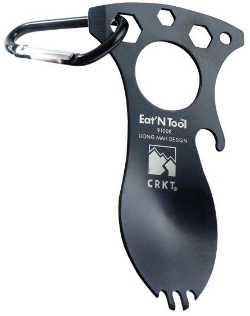
Get this awesome 1.5 oz multi-tool spork; it’s both a spoon and a fork – plus:
- 10 mm hex wrench
- 8 mm hex wrench
- 6 mm hex wrench
- Bottle opener
- Flat-head screwdriver
Multi-tools are always best for survival.
Now, as a side note, you won’t need a small knife because you can use your survival knife instead (a separate bug out bag checklist item later).
10. Small Collapsible Cup/Bowl
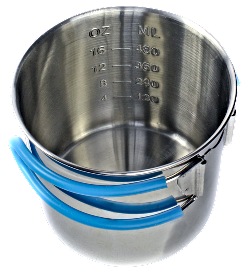
In our homes, we use plates, but they are heavy and take up a lot of space.
So instead, get one of these stainless steel cups that can double as a bowl, and they work great.
We recommend this one because it’s stainless steel, so you can boil water when you need to.
11. Braided Fishing Line
Fish is an excellent source of protein if you can snag them.
Fishing while bugging out is not always possible. However, you definitely won’t catch any without some fishing line.
Get some braided fishing line since it’s highly durable and can take more abuse than regular fishing line.
You won’t need much, so get the small spool, but you’ll have to decide what lbs. test line will work best for your needs.
The bottom line is that having some fishing line is a great survival tool to have in your bag.
It’s light, durable, and can help you catch fish or help with other survival needs.
12. Fishing Pole (small, collapsing, or pocket)
Recently some ingenious ultra-small fishing poles have been invented, like this small fishing rod from Emmrod.
This rod works fairly well (especially for how small it is) and easily fits into any size bug out bag.
Make certain to take one with you on your next fishing trip so you can get experience using it.
13. Yo-Yo Fishing Reels
I recently stumbled on these ingenious little devices.
↓ Yo Yo Fishing Reel In Action ↓
You can set several of these out, leave them, and then come back to check on them later.
So you won’t have to waste precious time actively fishing.
You’ll have better things to do mid-bug out than casting and reeling for hours with no guarantee of success.
Better to set your fishing yo-yos up and come back later.
If you catch a fish or 2, you’re ahead of the game, but if you don’t, you didn’t waste a ton of time.
14. Hook, Swivel, Sinker Set
We’ve already covered fishing lines and poles, but without hooks, swivels, and sinkers, you’re going to have a hard time catching anything.
Keep it light since you only need a small number of each. This little case includes 75 pieces which you should remove about 2/3 of them before packing, to save weight.
15. Portable Light Weight Stove
This piece of survival gear is a personal choice of whether to include it in your bag or not.
You CAN definitely survive without it and save the weight. Your call.
With that said, you can use it to boil water faster than over an open fire. It also makes your freeze-dried pouch food preparation both easier and faster.
Another consideration is stealth.
A fire can give away your position to others, especially at night. However, with this small stove, you’ll be able to cook your food without nearly as much exposure.
Note: The Solo Stove Lite is only 9 oz and doesn’t require additional stove fuel!
It works with just a few sticks and twigs – this helps to save pack weight!
Watch this video to see exactly how this stove works:
↓ Never Buy Fuel Again! Solo Stove Review ↓
16. Additional Stove Fuel (if necessary)
Depending on your type of stove, you may need to purchase a couple of fuel containers to go with it.
Grab a couple and try to use them as sparingly as possible.
Eventually, they will run out, but if they get you to your bug out location before they do, then you win.
17. Snare Wires
Setting up snares overnight might bag you a couple of squirrels or rabbits on the go.
Snare wires are a lighter option than traps, so they are the right choice for your bug out bag.
Be forewarned, though; they won’t be of much use unless you know what you’re doing.
However, they can be incredibly useful when bugging out if you learn the art of snaring.
18. Survival Slingshot
You can learn how to use a slingshot quickly with some dedicated practice.
Like most survival skills, it will take some practice, but this lightweight hunting slingshot is a decent option for sourcing some protein.
↓ Hunting With A Slingshot ↓
19. Daily Multivitamin Supplement
Stash some daily vitamins to help maintain your overall health.
Your diet will become severely limited in the wilderness, so taking a daily vitamin supplement will help keep your mind and body strong.
Want a Downloadable and Printable Version Of This Bug Out Bag Checklist? Click Here To Get Your FREE Copy Of It.
Bug Out Clothes And Warmth Supplies
Rule #1. Only carry as much clothing as you need for survival.
Rule #2. Don’t forget rule number 1.
Spare clothes will take up too much precious pack space and weigh more than you think. So try to limit additional clothes to just a couple of the main undergarments.
Plan on wearing the same set of durable clothes (like a pair of tactical pants) every day, and then change out your undergarments to maintain reasonable hygiene.
Remember, if you’re bugging out, it’s because a survival event forced you to leave, so multiple changes of clothes are not a luxury you can afford.
20. Fresh Socks
While I suggested you compromise on your main clothes (shirts and pants), I don’t recommend the same for your socks.
Your feet are just too important during a bug out. You can’t afford to get trench foot or severe blisters.
So rotate a fresh pair of socks daily.
The socks I’ve trusted with my feet on the trail for years are smart wools.
They are thick, warm, and comfortable when you’re walking long distances.
Pack one pair and wear one pair. Wash, dry, and rotate daily.
21. Quick-Drying Undergarments
Pack the quick-dry variety of undergarments so you can wash and then tie them to the outside of your pack to dry.
They are designed to dry quickly, so you only need one spare set of underwear and an undershirt in your pack. Rotate daily.
22. Sewing Kit
Since you’re only taking one main set of clothes (the set you’ll wear every day), you’ll need a small light traveling sewing kit.
A sewing kit allows you to mend your clothes should they rip or tear on the trail.
23. Safety Pins
Safety pins are designed specifically to pin clothes together.
So in a pinch, having a few stashed to hold a rip together until you can stitch a more permanent patch makes sense.
These safety pins are heavy-duty, so they work better in tough environments than regular ones.
24. Survival Gloves
You’ll need a set of warm gloves when it gets cold out.
I pack a set of Mechanix gloves because they’re designed for people who work with their hands.
With these gloves on your hands, you’ll have enough dexterity to use your survival knife or a firearm without taking them off.
25. Stocking Cap
In cold weather, plan to retain as much body heat as possible.
And while it’s a myth that we lose the majority of our body heat through our heads, it’s still wise to keep your dome covered in the cold.
Pack a camouflage stocking cap to avoid detection in the wild or a gray one if you must travel through a city.
26. Body Warmers
Keep a few body-warming packets stashed in your survival pack, just in case.
Then save them for serious emergencies, just before the threat of frostbite.
You can’t afford to lose your fingers or toes to frostbite in survival. That situation would be game over.
27. Rain Poncho with Hood
Nothing will drain heat from your body (and from your soul) more than hiking in drenched clothes.
It’s a miserable experience and very dangerous in the cold.
This Princeton study shows that “Generally conductive heat loss accounts for only about 2% total loss. However, with wet clothes, the loss is increased 5x.”
So pack a poncho. Ponchos are thin and light and take up limited space.
Get one with a hood to keep the rain off your head.
Also, get a durable one that won’t tear easily in the rugged wilderness. It may cost a few dollars more, but it’s worth it. Because if you’re cold and wet for long, hypothermia is coming.
Want a Downloadable and Printable Version Of This Bug Out Bag Checklist? Click Here To Get Your FREE Copy Of It.
Shelter And Bedding Options
Your choice of bug-out survival shelter comes down to personal preference.
Personally, I don’t pack a full-fledged tent. The tent poles and anchors are too heavy.
Instead, I use my survival skills and knowledge to make a basic survival shelter.
28. Tarp Shelter
With a durable waterproof survival tarp and key survival skills, you can create a space that is as good as a traditional tent.
It will:
- Keep the rain off you
- Break the wind,
- Give you a “safe” space to sleep at night
So why carry all the extra weight of tent poles?
Invest in an Aqua Quest tarp; they’re made for the rugged outdoors and have tons of extra tie-down grommets.
Jason will show you how to build a tarp shelter in under 5 minutes below:
↓ How To Build A Tarp Shelter & Conquer The Elements ↓
29. Survival Hammock
A quality hammock is another survival solution for sleeping.
Combine a good sleeping bag with a hammock, and you’ll be warm, off the ground, and dry.
All you need is a couple of trees and some paracord to tie off.
Get one with a built-in mosquito net, or check out the latest hammock tent designs for survivalists.
30. TACT Bivvy
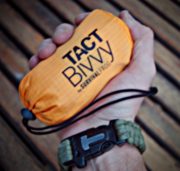
This TACT Bivvy is an emergency survival blanket that fits in your hand.
It’s about as small and lightweight as you can get but will keep you warm and dry even in the worst weather conditions.
I wish everyone would at least put one of these in your vehicle’s glove box; these TACT Bivvy’s save lives.
Get one and add it to your pack.
↓ Best Bug Out Bag Shelter – TACT Bivvy Review ↓
31. Sleeping Pad
While a sleeping pad provides some comfort, its primary survival function is to insulate you from the cold hard ground.
You need something between you and the ground because laying directly on the ground sucks the warmth and energy out of your body.
You can forgo a pad and get insulation by building a layer with wilderness debris (i.e., leaves, pine straw, etc.) but only if you know what you’re doing.
Get this light, durable option.
32. Zip Ties
If you stop to think about it, zip ties are an amazing invention.
They are as tough as hell, and light, and allow you to create tight connections. Many police departments use a thick set of zip ties instead of handcuffs.
They have a large variety of additional survival uses too.
As far as shelters go, use them to tie branches together to create simple survival shelters.
33. Paracord Survival Kit
Paracord has so many survival uses that I could have added “paracord” to nearly every bug-out bag checklist category.
In the case of shelters, it can tie branches together or attach your tarp to trees. It can also anchor your hammock to trees.
That’s why you should have some paracord with you at all times.
Want a Downloadable and Printable Version Of This Bug Out Bag Checklist? Click Here To Get Your FREE Copy Of It.
Fire Starting Tools And Gear
You need 3 independent ways to start a fire.
Fire is your lifeblood in a survival emergency. You need it to purify water, cook food, for nighttime warmth and safety, and it’s a huge morale booster.
Once you have your 3 critical fire-starting tools, practice, so you know how to use them.
And if you really want up your survival game, learn how to start a fire with sticks.
It takes some serious survival skills to start a fire with sticks in high wind or wet conditions.


